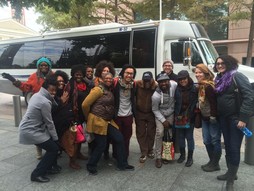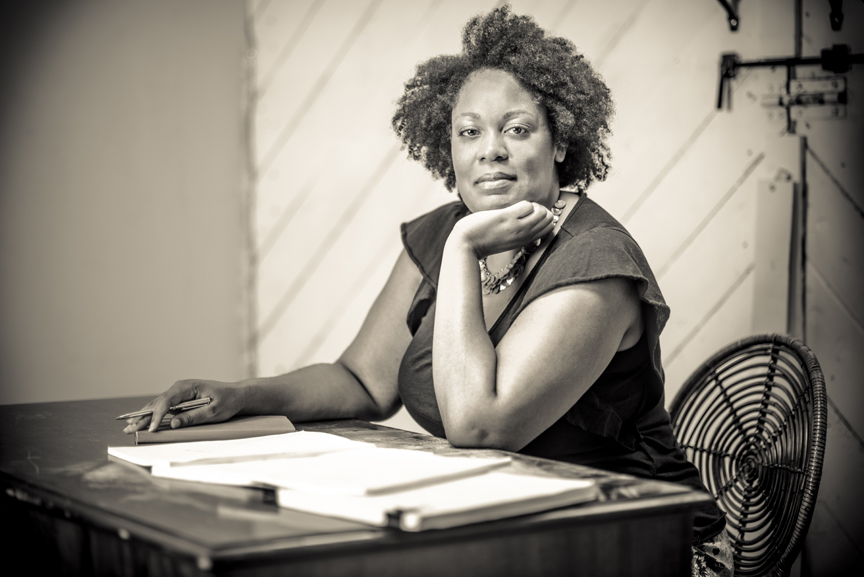 DX team and Dallas partners touring Dallas. Photo by Matthew Cumbie. DX team and Dallas partners touring Dallas. Photo by Matthew Cumbie. Since the 2014 Summer Institute: Stepping Toward Racial Equity, my colleagues at Dance Exchange have been working with artists, historians, and activists in the Dallas-Fort Worth area to create a 10-minute interactive performance, Find the Burning Question Collaborative Movement, and a 90-minute breakout session, Creative Convening: Moving Racial Equity Forward Through the Arts, at the national Race Forward/Dallas Faces Race conference. Here’s more information about the project: Dance Exchange is creating this work in partnership with the newly formed Dallas Faces Race community coalition, Race Forward’s 2014 Facing Race Conference, and The Embrey Family Foundation. This collaboration will amplify groundbreaking social justice work currently being brought to life throughout Dallas in order to connect local resources to local action. Through igniting the power of intergenerational dialogue and action, Dance Exchange and Dallas partners will co-create a performance highlighting the past and present of the Dallas Arts District, which was the site of a Freedman’s Town established during the Reconstruction Era. The purpose of this work is to “leverage the power of the arts towards advancing racial equity in Dallas and beyond. By engaging artists and communities in intergenerational dialogue and creative practices, we are collaboratively building new relationships, unearthing new understandings, and building new avenues for action and change.” In addition to serving as dramaturgy, my colleagues at Dance Exchange have invited me to blog about the creative research we gathered during our time in Dallas. DX team and Dallas partners touring Dallas. Photo by Matthew Cumbie. On Wednesday, November 12, Linda Jones (Dallas based creative partner, journalist, writer, educator, and community advocate), and Don Payton(Dallas based historian) led us on a four hour historical tour of Dallas. Here are the locations and landmarks we visited: Freedmen Memorial Park: the cemetery that honors the lives and burials of more than 5,000 freed men, women, and children. Dallas Arts District, the three remaining buildings of Freedmen’s Town, which was a small community that was formed by men and women freed from slavery in the mid-1860s. St. Paul’s United Methodist Church, cConstruction began in 1901, the church was build brick-by-brick by members and was completed in 1925; Dallas Black Dance - founded in 1976 and housed in the historic Moorland YMCA building; and Booker T. Washington High School – established in 1892 as Dallas’ first school for African Americans. Downtown Dallas: Cattle Drive Sculpture – a somewhat controversial sculpture that celebrates the 19th century cattle drives along the Shawnee Trail; Deep Ellum – one of the first commercial and residential districts for the black community and stomping grounds of legendary blues and jazz artists such as Blind Lemon Jefferson, Huddie “Lead Belly” Ledbetter, and Bessie Smith; and the Knights of Pythias Temple – designed by Dallas’ first African-American architect, William Sidney Pittman (and the son-in-law of Booker T. Washington), the temple served as the social, professional and cultural center of the center of the city’s black community in the early 1900s. South Dallas: African American Museum – started in 1974 , it’s the only museum in the southwestern United States devoted to the preservation and display of African-American artistic, cultural and historical materials and has one of the largest African-American folk art collections in the U.S.; Pan African Connection – home to a vast collection of African arts, fashion, jewelry and books, South Blvd/Park Rd (via MLKing Blvd) – historically black community going through community development and gentrification; Juanita Craft Civil Rights house – it was here where the Montgomery Bus Boycott was planned and Craft was played a central role in integrating University of North Texas and the University of Texas Law School as well as the 1954 Texas State Fair; and many Dallas theaters, restaurants, and lunch counters, and the South Dallas Community Center, 10th St. Historical District: The Bottom – a historic black neighborhood at the bottom of hilly terrain and Benny Walker’s neighborhood junk art display established as part of Activating Vacancy, an initiative designed to stabilize and invigorate the area. We ended our visit at the Dallas Museum of Art. Some folks explored the museum, while others went to rehearse for the Facing Race Opening Ceremony and also to Elaine’s Kitchen for some traditional Caribbean/West Indian cuisine. I met with Ouida to discuss ways to gather creative research and capture our experience over the course of the conference. Over the next few posts, I’ll be sharing more about my experience attending several panel discussions, plenary sessions, and presentations. The lens of my inquiry will be inspired by the following questions, which also guided Dance Exchange in the development of their work:
I look forward to sharing my thoughts, learnings and discoveries with you.
0 Comments
Your comment will be posted after it is approved.
Leave a Reply. |
My BlogI'm a playwright, dramaturg, and teaching artist. It is here where you'll find my queries and musings on life, theater and the world. My posts advocate for diversity, inclusion, and equity in the American Theatre and updates on my own work. Please enjoy!
Categories
All
Archives
June 2020
Reading List
|
